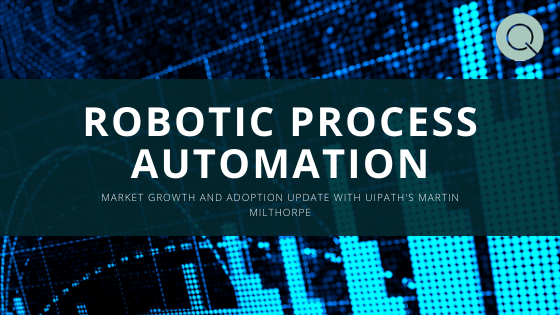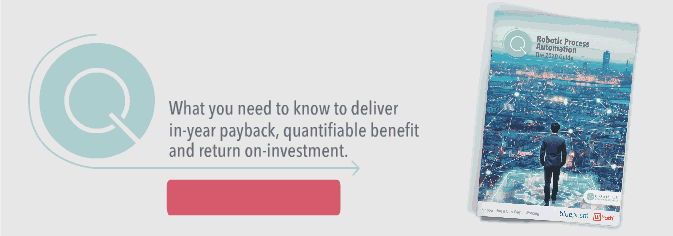
Qualifying Robotic Process Automation with help from UiPath's Martin Milthorpe
Robotic Process Automation (RPA) is the fastest-growing segment of the global enterprise software market, according to analyst firm Gartner, but like any technology, it has had its growing pains. While there are a number of local success stories, most local companies have yet to fully harness the potential of the technology.
The video above is an extract of a wider conversation with Martin Milthorpe. The full video,which is one hour in duration, contains additional conversation on, cognitive automation, digital transformation and the foundation of successful automation programmes.
Editor's note: This content was originally created an intended for distribution in March 2020, prior to the impact of the Coronavirus epidemic in New Zealand. The video and podcast content are un-altered from the original recording. This article has been updated with reference to the impacts of Coranvirus as at April 17th, 2020.
This is the first article in this three-part content series which will firstly address the growth in the global RPA market, followed by part 2 on how automation will support businesses through the coming challenges associated with Covid-19 and the impending recession. Part 3 will address what to focus on how to create immediate business value and build the foundations for a scalable programme.
Robotic Process Automation (RPA) has been considered a significant technical evolution in the automation landscape. Since its inception in the early 2000s its capability has grown rapidly to assume a prominent position in the enterprise technology mix and be a strategic lever for digital transformation.
I recently had the chance to chat with Martin Milthorpe, Australia and New Zealand Regional Partner Director for UiPath, about RPA, adoption trends and where the market is going in New Zealand and Australia.
Based on HFS Research Milthorpe shared, since 2017 RPA has maintained a compounding annual growth rate of over 30 percent per year, that’s projected to continue until 2023.
The figures show it’s a market that has soared from US$1.4 billion to US$4.4 billion in 2019. Growth was expected to hit $5.9 billion this year, which includes software and professional services. This year, the software side is forecast to hit $1.5 billion globally.
These projections were made before the Covid-19 epidemic so we can expect a short-term disruption to the growth of RPA (and commerce in every sector), but in the mid and long-run we expect to see these projections holding as businesses accelerate digital transformation agendas.
Milthorpe says those numbers are panning out across New Zealand and Australia too. UiPath grew 375% last year off a smallish base. It is, he notes, acknowledgement that customers are seeing real value in the automation solutions and programmes they are implementing.
Here at Quanton we’ve seen customer numbers more than treble. What’s exciting is we’re seeing the number of customers with active programmes, as opposed to just pilots, also growing.
If we go back 24 months ago, when RPA was in its infancy in New Zealand, we really only had a small number of customers who were in programme stage, the rest were in pilots. Now, we’ve not only seen the growth in adoption through the New Zealand market, but a number of the pilot stage customers have now scaled their offerings and are running independent programmes.
From pilots to industrialisation
Milthorpe highlighted some interesting figures from the HFS report, which suggests that 74% of the market were engaging with RPA capability to some degree.
That report - which is US-based - also shows that just 13% of organisations have really industrialised automation. By that, automation is being used across the business, in multiple departments – from helping marketing identify new opportunities to assessing job applications, and, from on boarding new staff for HR to being used in IT, sales, finance and procurement.
It’s a figure Milthorpe says holds true for UiPath’s 6,000 global customers, about 13% of whom have scaled up and industrialised their automation projects. Another 27% are moving into production.
I also cross-referenced a KPMG study published in November 2019 which claimed 26% of companies interviewed had deployed RPA at scale across the enterprise sector. Over half of those who responded said their use of RPA was selective and siloed by functions, however in three years 83% of respondents expected to have RPA deployed at scale.
If you think these numbers seem high for New Zealand, I tend to agree with you. These figures are prepared by US firms and based on American enterprise. If my scope is on the New Zealand enterprise market (which is NZ$100 million plus in revenue), I would estimate that are only 1-3% of programmes which are industrialised and scaling. My definition of industrialised, is a programme with an established Centre of Excellence that sits across the total enterprise. As more of a guestimate I would be inclined to think that up to 30% were some combination of conducting a pilot or have a low scale programme being managed within a department.
That means there’s a huge opportunity within the existing RPA user base to help scale up, identify opportunities and put in the right operating model.
As Milthorpe notes: “It’s not enough to go in and automate process, it’s about how do you embed into organisational operations model - governance risk compliance, prove value.”
Over the next couple of years Milthorpe expects to see the 27% currently moving into production to begin scaling up and industrialising.
“It’s not a “tech transformation”, it’s a “cultural business transformation”. All things around how a business operates, how they decide if they will build new business unit, what will be the human workers’ roles, what functionality can the bots provide…it’s going to take time,” he told me.
Platform driving change
People are also now looking past automation. No one in New Zealand has yet maximised the opportunity for RPA. Even those businesses which are well into their automation journey have yet to tap out the full potential. They’re now looking to intelligent automation, artificial intelligence and a range of other offerings to spread the full potential of automation across their entire business.
This is made clear in the HFS data shared by Martin, which showed equally high levels of business engagement with Smart Analytics, Computer Vision, Machine Learning and Natural Language Processing.
Referring back to a KPMG study which presents similar results, claiming 30% of companies were using AI or Machine Learning selectively, however in three years half of those businesses expected to be deploying these capabilities at scale.
Smart technologies like those mentioned, are becoming increasingly available to businesses through as-a-service and subscription models like Amazon, another trend I addressed in The Top 5 Business Process Automation Trends for 2020. Technologies like UiPath and Blue Prism are placing themselves at the forefront of intelligent automation by strengthening native functionality like Computer Vision, the ability for software to understand digital images and content on a screen and extending their integration capability with core functionality like Machine Learning. UiPath for example has introduced the ability to deploy a Machine Learning algorithm directly into an automated process or integrate to common Natural Language Processing engines.
Current times
Of course, we couldn’t talk RPA - or any other topic at the moment for that matter - without mentioning the Covid-19 impact.
As the video content and podcast were recorded before the growing economic impact of Covid-19 on New Zealand, Milthorpe admits that some more traditional organisations are now bunkering down, diverting their budget into their war chest, to get through the tough times that lie ahead.
Yet others are starting to ramp up their automation projects, believing the more they can get done now, the better their business continuity planning will be.
I share this perspective and our own observation is that businesses with established programmes and capability, or business who were in the advanced decision-making stages of RPA adoption, are factoring automation heavily into their plans to whether the current business storm.
I also acknowledge that businesses can continue to develop, deploy and manage automated processes 100% remotely.
And UiPath has been at the forefront of the Covid-19 automation work. It’s built a process – which came out of its team in China – to help businesses screen staff with health checks and enable companies to ensure they’re isolating the right people, at the right time.
Internally we’ve deployed this process, which was made freely available by UiPath. I’ll discuss this use case fully in the separate article, next week.

The summary of this piece is RPA as a capability, and leading RPA platforms like UiPath and Blue Prism have been on exponential growth journeys.
We are yet to understand and see the full impact of Covid-19 on our businesses and economy, but the current business environment isn’t going to slow the growth of automation – it’s going to fuel it.
I firmly believe, alongside my colleagues and friends at Quanton, that automation will be a strategic tool to help businesses achieve business continuity and transform their operating models to be sustainable in the ‘post Covid-19’ future.
We’ll explore this topic further in part 2 of this content series which will be published with Garry Green.



